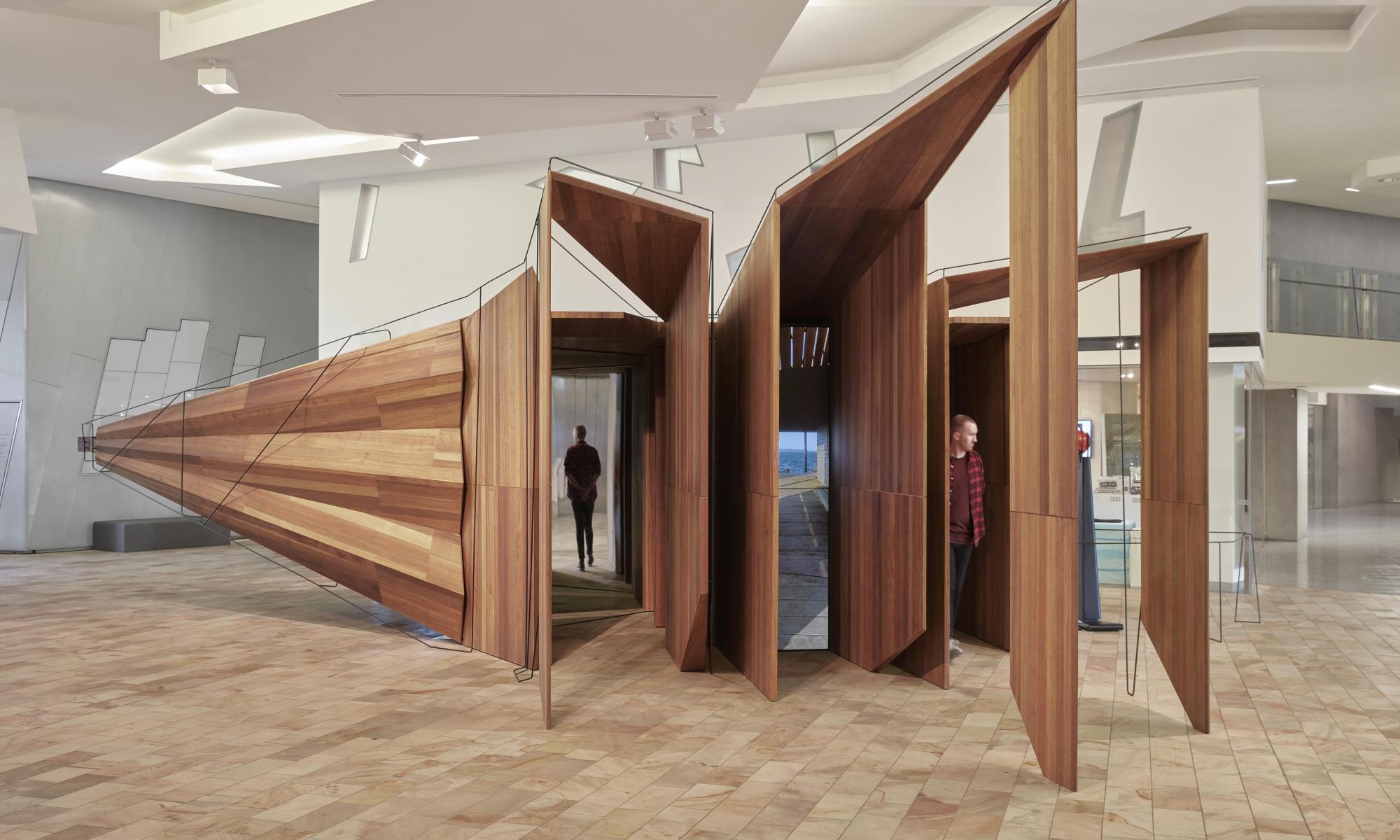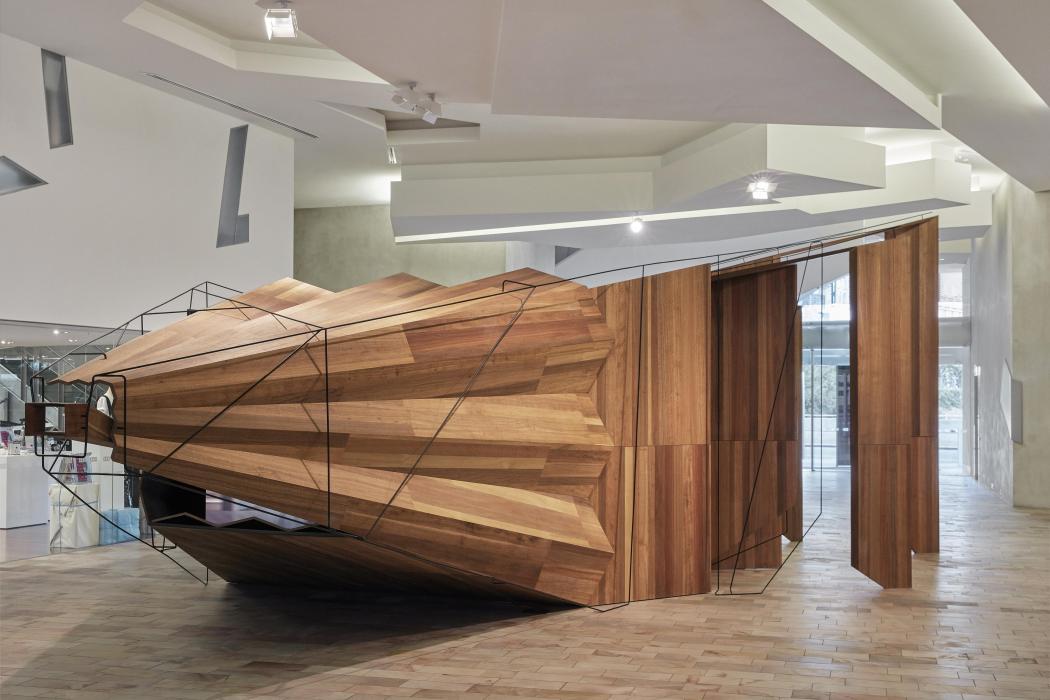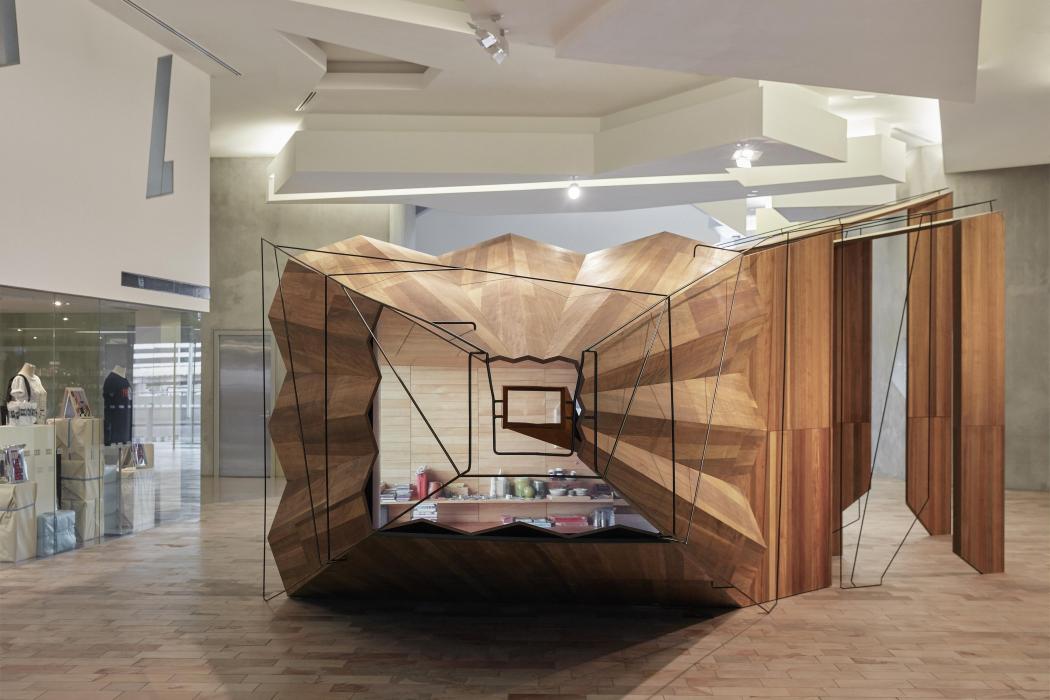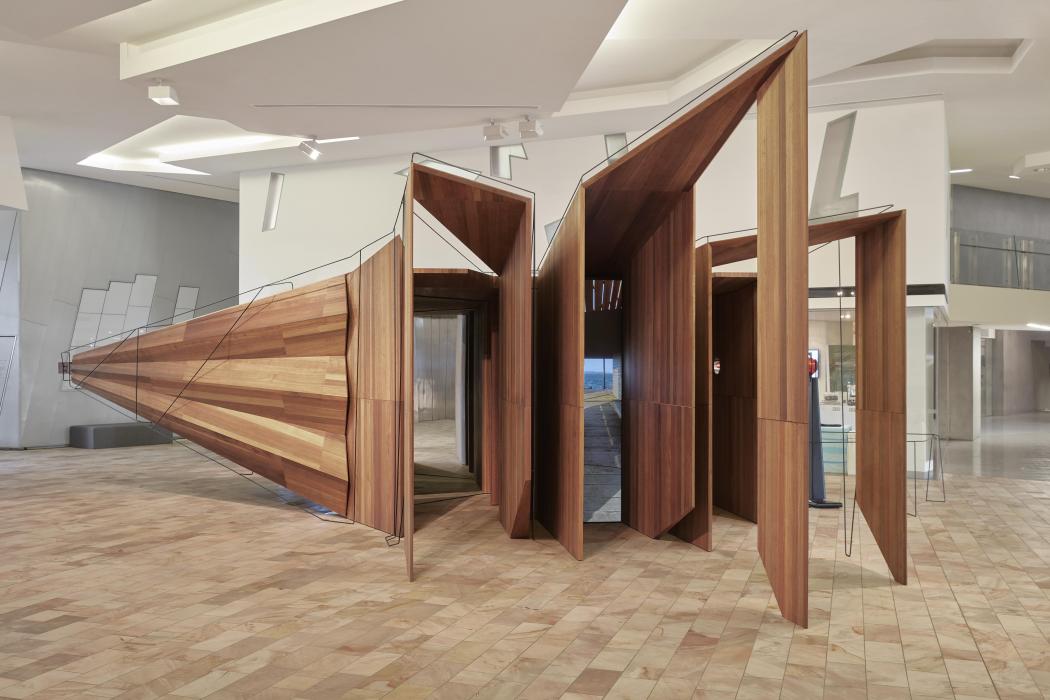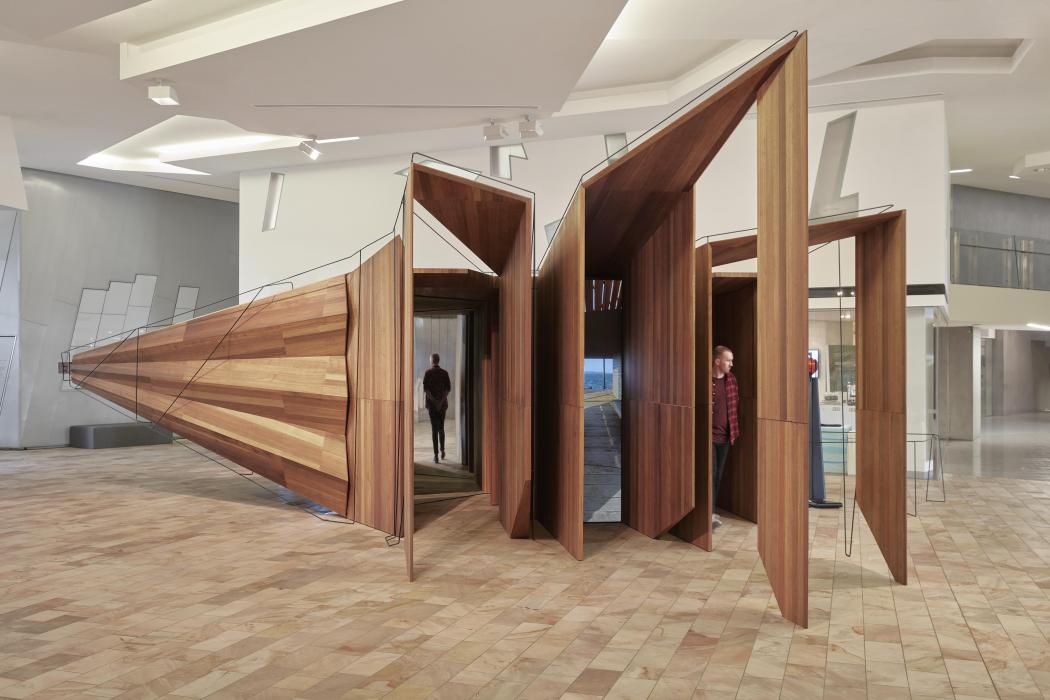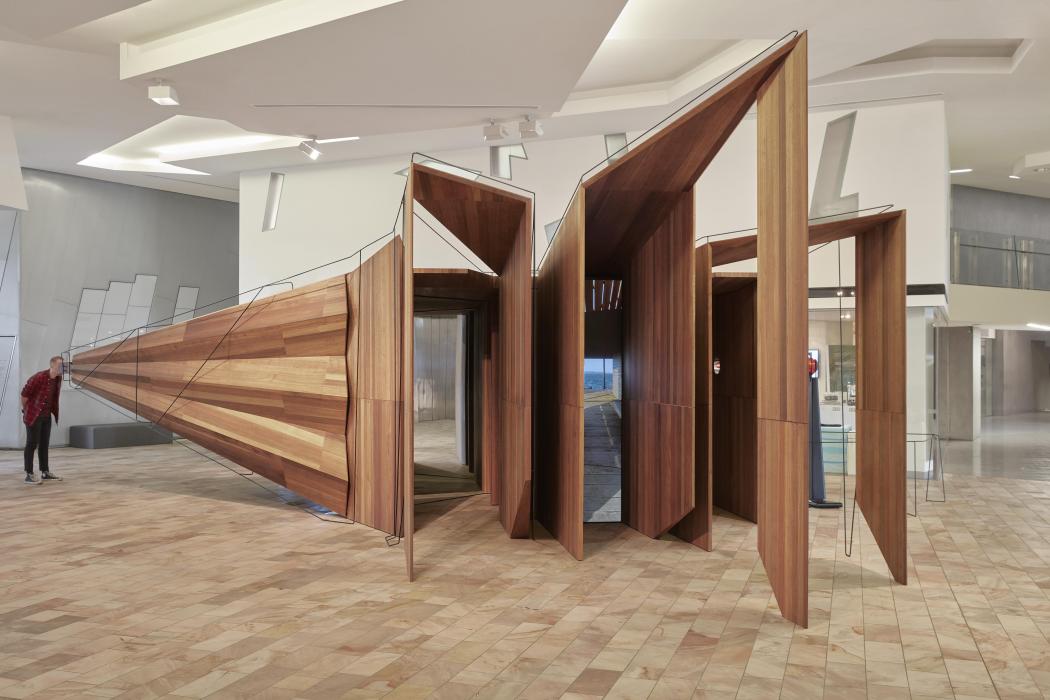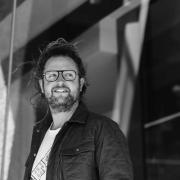Looking in, looking out: Somewhere Other by John Wardle Architects.
A first glance, Somewhere Other is all about looking. Views looking in and looking out, cones of vision, circular openings, periscopic mirrors, two moving image works, and a bright orange piece of Murano glass that is strikingly reminiscent of a telescope. There is a jaunty angularity consistent across the timber and steel construction, but it could be discerned as consisting of two parts. The first is a large faceted cone, that narrows to a point with a solid timber viewing station for a single viewer, that plays with abstracted forms of venetian carnival masks and the helmet-mask of bushranger Ned Kelly. From this point, we look in to a moving image ’tapestry’ of projects by John Wardle Architects shot and edited by filmmakers Coco and Maximilian.
The other part seems more concerned with looking out and through the structure. Within a series of three perspectivally exaggerated portals, works by Natasha Johns-Messenger create a sense of radical porosity—at points it seems possible to look straight through what we already know to be a solid timber construction—and at other points our view is displaced. In another section of the structure we look out from inside, through a porthole with one of Johns-Messenger’s mirrored surrounds and out through Leonardo Cimolin’s glass work. As with many of Johns-Messenger’s works, things aren’t quite where we expect them to be. These different facets of Somewhere Other constantly shift our point of view around the structure. What begins with a very legible invitation to view, ends with a series of questions of just what it is we are looking at, and indeed how reliable our vision might be in constructing an understanding of the world around us.
When I think about the idea of a construction of a view, particularly in an architectural project, I am immediately transported back to my time at architecture school. Sarah Treadwell and Sean Flanagan taught me two-point perspective drawing the old-fashioned way. A web of construction lines linked architectural drawings of plan and section, along with other necessary construction geometry including a viewing point, picture planes, horizon lines and vanishing points. The drawings would take a long time, and even on the largest of drawing boards, the resulting perspective outline was disappointingly small. The other significant takeaway from these drawing classes was that we don’t actually see the world in perspective, at least not as an architectural drawing would have it—a single eye, fixed in space—and the perceptual games at play in Somewhere Other make this abundantly clear. Rather than the flatness of a fixed singular point of view, what we see is constantly in motion and stereoscopic vision provides us with an ability to perceive depth. These tensions are evident in the second film work housed within the project. Described as 1:1 scale films, the idea is to locate us somewhere other, in this case in the midst of various architectural projects, at the scale of lived experience. But as any architecture student will also remember, perspectival views are never measurable so any claims for these filmic representations to be at actual size must come with some caveats. The structure surrounding the films creates a trompe l’oeil that exaggerates a sense of depth, an illusion that vanishes as soon as you step towards them and attempt to inhabit the space of representation. It’s a disconcerting moment, but one which contributes to, and is consistent with, the perceptual play across the project as a whole.
There are other lovely moments across the project that remind us that architecture isn’t (or shouldn’t be) just about how things look, but how they make us feel. As you walk around the structure it emits creaking and groaning noises; sounds of materials flexing in response to the effects of weather that remind me of being on a ship. It turns out these sounds relate to what is happening in the ’filmic tapestry’—more of which in a moment—but thinking of a ship brings up a raft of other associations; to Venice and the Architecture Biennale where Somewhere Other was first exhibited in 2018, to the instabilities of balance that occur when we are all at sea, to ideas of displacement when a vessel is placed into a body of water, and the ways in which Johns-Messenger’s mirrors displace our views and expectations. But to loop back to Coco and Maximilian’s ‘filmic tapestry’ for a moment, with its stitching together of footage of interiors from a range of projects by John Wardle Architects in a continuous pan. The film layers views over other views creating seams between these projects, sometimes so subtle as to be barely noticeable, at other times jarring us to account for apparent changes in gravity and orientation. There is something Escher-esque in these films, though that could be a lingering effect of seeing this project immediately after coming from the Escher X Nendo exhibition at the ‘other’ NGV. Both films, but the tapestry project in particular, are a satisfying collaboration between filmmakers and the architecture office, and it has me imagining other such collaborators. It would be fascinating to see how someone like Daniel Crooks might construct new spaces and journeys through an architectural oeuvre, particularly in the context of a project that plays with perspectival perception such as this.
Somewhere Other is also appealingly tactile. Clad in spotted gum, the faceted forms ripple and encourage us to brush against them as we move through and around the various spaces. These timber surfaces are punctuated by black-painted steel rods that echo and expand parts of the structure. And like the filmic tapestry, the spotted gum also has a seam that joins its different parts together. A horizontal datum, at what I guess is exactly one metre above floor level, joins the lower planes to the more elaborate vertical planes above. This reads as another allusion to architectural drawing, where the plan is a drawing of what is revealed after the project is cut through at this one-metre reference level. And so for all this solidity and tactility, it is also pleasingly drawing-like and sketchy. The relationship between steel rod and timber surface suggests another relationship to architectural drawing, where spaces are sketched out in three dimensions and delimited in lines, before being committed to in planes of spotted gum. In some ways the project feels like a scaled-up cardboard and wire model, giving it the provisional feeling of a stage set in a theatre. (And indeed, another reference the architects invoke is Andrea Palladio’s Teatro Olimpico in Vincenza, which features trompe l’oeil scenery by Vincenzo Scamozzi.) Somewhere Other invites us to engage and perform alongside it. The project welcomes us in, but then resists giving any straightforward answers. Instead we leave with a mix of questions and associations about the ways we try to make sense of the spaces around us as we move through them.

